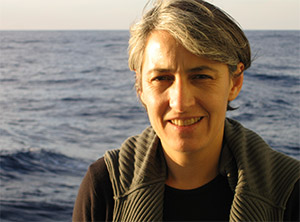Nadine Le Bris
Marine Chemist, University of Paris
 Nadine Le Bris, Marine Chemist, University of Paris
Nadine Le Bris, Marine Chemist, University of Paris You started out by studying atmospheric chemistry. How did you wind up focusing on the deep ocean?
Originally, I was studying dust clouds in the atmosphere. As winds blow over the world’s deserts, they can pick up huge amounts of dust and minerals that travel hundreds of kilometers before settling into the ocean. The dust is rich in iron, which is an important nutrient that feeds phytoplankton [tiny organisms that live in the upper ocean]. I was looking at redox processes that occur in those clouds and trying to figure out how they change the iron into a form that the organisms can use. After my Ph.D., though, I moved to marine chemistry, and have been developing sensors that can measure chemistry directly in the deep ocean. Ultimately, I’m using those to see how living organisms on seafloor interact with the chemical environment around them.
Did developing those instruments spark your curiosity about chemistry at vent sites?
Yes, of course. One of the main reasons we were developing those sensors was to measure chemical conditions directly in the deep sea environment. The deep ocean is one of the most difficult environments on the planet to work within. It’s hard to reach, hard to take samples, and hard to keep those samples stable until you have a chance to analyze them. Usually, when you take a fluid sample from the bottom and bring it to the surface, the sample tends to change. This is especially so with vent fluid. If you don’t maintain it under high pressure, gases may bubble out of the fluid—so what you measure on board a ship might be very different from the chemistry that animals at the vents actually experience. If you have sensors that can measure the chemistry from the ocean floor, though, you can get around that problem.
How would you describe what you’re doing on this cruise?
On this cruise, I’m using these sensors to measure parameters like pH and temperature at vent sites on the ocean floor. I’m also measuring levels of certain chemicals, like hydrogen sulfide. Some of the sensors are autonomous, which means that they can work on their own after you leave them at a vent. They’re battery powered, and they have built-in memory, so we can pick them up again after a few days and download all the information they’ve collected. Ultimately, we want to capture the small-scale changes in chemistry that occur in vent fluids, and also measure how tubeworms, mussels, and other animals affect that chemistry.
Why is it important to understand how chemicals change at the vents?
Chemicals called “sulfides” are the main energy source for life at the vents—but sulfide (especially hydrogen sulfide) is also toxic in high concentrations. If you have a lot of sulfide, you usually also have an acidic environment with low oxygen, which can make it hard for some organisms to survive. So it’s a balance. These chemicals are a source of energy, but they’re also a source of stress to some animal species and even microbes. Of course, many vent organisms have adapted to that stress, but it still creates a limit that they have to work around. Understanding how that balance changes is very important for understanding how the entire vent ecosystem functions and evolves over time.
How fast can those chemicals change over time?
Well, it depends. The main cause of change is due to volcanic eruptions. They can change fluid composition dramatically. Not all changes are that obvious, however ; deep-water currents and even biological activity can also create small-scale changes. As organisms grow at the vents, they can cause physical changes in their environment. When tubeworms block the mouth of a vent, for example, they can channel the fluid, which affects how it mixes with seawater. Animals can also change the chemistry of the surrounding water by interacting with it in other ways. Near mussel beds, for example, the level of sulfides in the water is lower than it might be at other sites around the vent, and sometimes the sulfide disappears entirely. That’s because microbes living inside the mussels need it as an energy source, and can use up most of the available sulfide from the fluid that flows through the bed. By sensing the change in sulfide levels that occurs, we can get a better idea of how those animals affect the environment around them as they grow.
Sensing these changes over time is also very important. A single sensor reading will give you a snapshot, but if you have a lot of readings over a few days, you start to get a better picture of what those organisms experience on a regular basis. For example, what is the maximum or minimum pH level over the course of a day? What is the maximum sulfide level? As chemical levels change, they can affect how an organism grows.
The ability to sense these changes is not something we could do until pretty recently. In the past, we were only able to measure temperature over time. Now we can measure a lot of different chemicals using our devices.
You’ve collaborated with many of the scientists aboard this ship for years. What’s it like to be able to work with them again at sea?
It’s really nice to be here with everyone now. Collaborating with them over the past few years has been a nice way to do science, since each of us comes from a slightly different field, like microbiology, chemistry, and ecology. In that way, we each bring a different expertise to studying vent systems. By sharing time at sea and sharing data, we can better study those systems.
[Back
to top]
|

